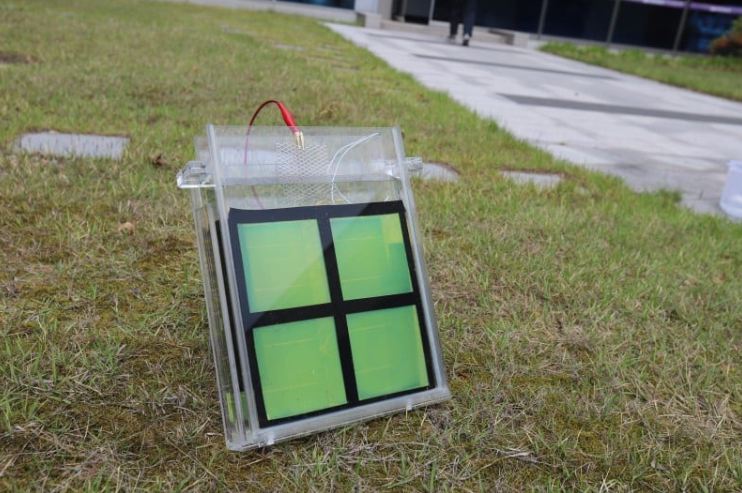Solar-powered hydrogen production has long promised zero-emissions fuel from abundant sunlight and water, but the pathway to commercialization remains obstructed by slow, costly manufacturing processes.
A recent advance from the Korea Institute of Machinery and Materials (KIMM) may mark a turning point: researchers have developed a high-concentration precursor solution that dramatically accelerates the fabrication of bismuth vanadate (BiVO₄) photoelectrodes—critical components for photoelectrochemical (PEC) hydrogen production.
Under natural sunlight and without external power sources, the new BiVO₄ system achieved high and stable photocurrents using a 576 cm² ultra-large electrode array, assembled from four 144 cm² panels. This performance was made possible by an innovation in the precursor formulation—one that cuts processing steps from eight to one and boosts production speed by nearly sixfold.
The improvement addresses one of the central bottlenecks in PEC hydrogen: the inefficiency of fabricating high-performance semiconductor films over large areas. Conventional BiVO₄ processing is constrained by low precursor solubility (capped around 100 mM), requiring multiple rounds of spin coating and heat treatment to reach target film thickness and performance. Each iteration increases cost, complexity, and material waste, rendering the process commercially unviable at scale.
KIMM’s team, led by Dr. Jihye Lee of the Nano-lithography & Manufacturing Research Center, circumvented this issue by mixing acetylacetone, acetic acid, and dimethyl sulfoxide (DMSO) to create a stable, high-concentration precursor. This chemical optimization allows for one-step spin coating while preserving film uniformity and PEC performance—critical metrics in solar water-splitting applications.
BiVO₄, a metal oxide semiconductor with strong visible light absorption and suitable band alignment for oxygen evolution, has emerged as a leading candidate for PEC anodes. However, its widespread deployment has been hindered not by its theoretical efficiency—solar-to-hydrogen (STH) efficiencies above 5% have been reported in lab settings—but by scale-up challenges. The KIMM approach significantly alters this risk landscape.
Importantly, the system demonstrated hydrogen production under ambient solar conditions by pairing the BiVO₄ photoelectrodes with conventional silicon solar cells, avoiding the need for external power input. This aligns with broader industry trends prioritizing energy-autonomous hydrogen generation systems. While other research groups have explored tandem structures and photovoltaic-PEC hybrids, few have demonstrated stable, high-current operation in such large-scale, naturally illuminated conditions.
The team’s reported productivity increase—5.9 times higher than traditional methods—reflects fabrication speed rather than full system-level economics. Long-term durability, integration with hydrogen separation and storage systems, and lifecycle cost analysis will ultimately determine the commercial impact. Moreover, while patent filings are underway and the results have been peer-reviewed (Journal of Materials Chemistry A, Impact Factor 10.7), industrial validation is still pending.
The move toward large-area, scalable PEC systems is gaining urgency as nations pursue hydrogen strategies linked to net-zero targets. Yet, the sector remains fragmented, with commercial electrolysis via renewable electricity—particularly PEM and alkaline systems—capturing the bulk of investment and policy support. Innovations like KIMM’s may help diversify the hydrogen production toolkit, especially for regions with strong solar resources and limited grid capacity.
Standardization and manufacturability are the next hurdles. The development of reproducible, low-cost fabrication routes for oxide semiconductors like BiVO₄ could unlock new deployment models—such as modular PEC panels co-located with water treatment or solar farms. The scalability of KIMM’s approach will depend on its compatibility with roll-to-roll or batch coating systems, and its ability to maintain efficiency across environmental variables.
If successfully commercialized, the technique could shift the balance in solar hydrogen economics by reducing capital expenditures linked to photoanode fabrication—a non-trivial share of overall system cost. With mounting interest in “green hydrogen” from policymakers and corporate buyers, especially under evolving EU and Korean clean hydrogen certification frameworks, KIMM’s contribution adds a credible pathway to cost-competitive, sunlight-driven hydrogen generation.
Stay updated on the latest in energy! Follow us on LinkedIn, Facebook, and X for real-time news and insights. Don’t miss out on exclusive interviews and webinars—subscribe to our YouTube channel today! Join our community and be part of the conversation shaping the future of energy.





